Blue Mound Golf & Country Club, WI, USA
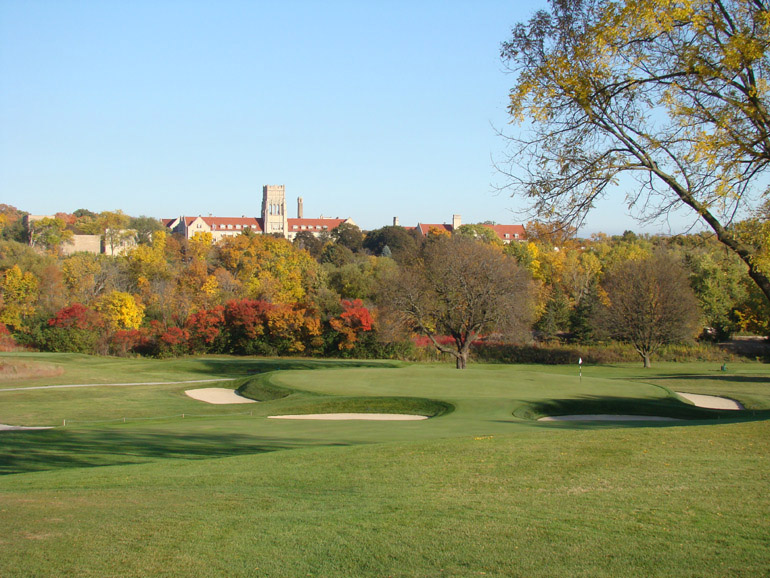
The grand game of golf offers few better distractions than autumn golf in Wisconsin. Pictured above from the right of the tee is the Short Hole at Blue Mound.
How should a golf architect be judged? Is it how well he works with superlative land? Or is it more instructive to see how he handles prosaic property? It turns out that talent is measured and revealed in both situations.
Of course, most properties aren’t located in the sand hills of Nebraska or beside a polo field. The virtues of most sites lie somewhere in between with good features here and there and undistinguished land elsewhere. How does the architect approach this challenge? Does he extract the essence of the best property while lending playing interest to the holes laid over the more mundane land? Equally important does he successfully knit these two territories together? Are the transitions seamless (e.g. Friar’s Head, Pacific Dunes) or is the golfer left wanting (e.g. Spyglass after leaving the best portion of the property)?
Located in southwest Milwaukee, Blue Mound has a superior collection of holes and is a wonderful exemplification of how an architect at the height of his powers solved this conundrum. Where the land had the most topographic interest, Raynor created the holes most often cited as favorites, the Short seventh and Punchbowl eighth. Yet, he also shined on the flatter land, especially the stretch now occupied by the first through fourth that play along the property’s perimeter. Where most architects would falter, Raynor built four superb greens: Redan, Double Plateau, Biarritz and Alps. More significantly he created four successful holes without moving much dirt between tee and green. He focused his efforts at these green complexes. After all, no one can name a mediocre hole that possesses a great green – there just aren’t any!
After tackling these four diverse but fun greens at the start of the round, the golfer is led by Raynor into the property’s best golfing land. There Raynor soared with a memorable nine hole stretch highlighted by the aforementioned glorious seventh and eighth. Today’s back nine is played diagonally into, around and out of a central depression. While the tenth is flat, its green is not (!) and the eleventh green butts up against a sharp drop-off. The twelfth tee shot is a thrilling oblique carry across a valley and the Redan thirteenth is played back downhill to a green bordered in back by a creek. The only blind tee shot comes at 14 and carries the golfer back up onto the flat land. On the way home Raynor sprinkles the terrain with challenge, especially at the sixteenth Leven and seventeenth Eden by virtue of built-up green pads and the resulting deep greenside bunkers.
All told, the holes reflect the natural surrounds while producing golf of a high order. There is no reason to think that any architect – dead or alive – could have done better with this property, and surely that’s the greatest compliment an architect can be paid.
How can it be, you ask?! If the course is that good, why haven’t I heard more about Blue Mound? The answer lies in the fact that this design, like many Golden Age courses, was covered up for several decades. Burdened by shrunken fairways, putting surfaces that occupied only ~70% of their original green pads and design features buried under a mass of newly planted trees, Blue Mound bore little resemblance to today’s gem.
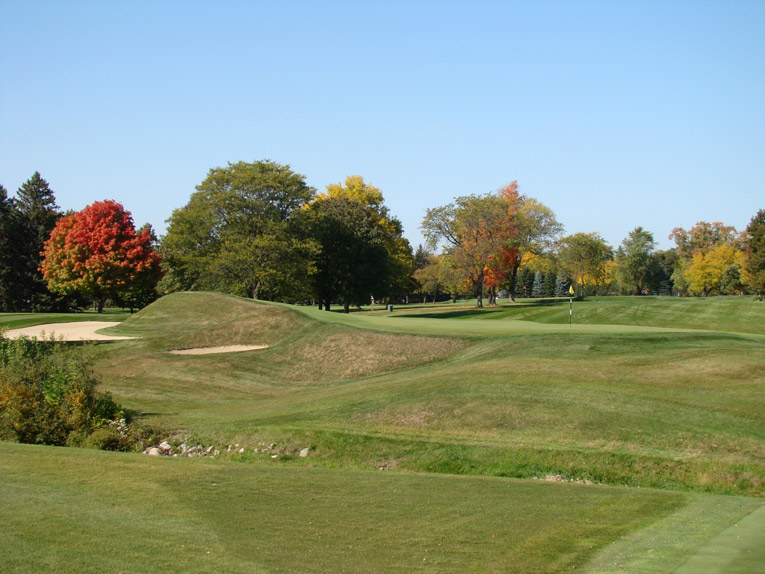
Standing here near the fourteenth tee, the prior par three Redan green was once invisible as it was masked by a row of spruce trees. Those days are well behind Blue Mound with Raynor’s design features once again happily shining through.
Things began to change in the mid-1990s. Just as Seth Raynor’s star was in ascendancy, a man from New Jersey named George Bahto burst into the professional shop to inform long time pro Barry Linhart that his membership was the proud possessor of a classic Raynor design. Eventually, the club board took note and in 1998 hired Bruce Hepner from Renaissance Design. Initially, Hepner picked away at the forest of trees and adjusted mowing lines. The restoration gained further momentum when Tim Venes was appointed Green Keeper in 2003. The following year, John Engelbrecht became President and Mark Vetter Green Chairman. This created a synergy with the right people now in place to drive a renaissance.
The ill-advisedly planted, fast growing spruce, ash and silver maple trees were soon eradicated revealing specimen trees of genuine substance and beauty. Fairway width was reclaimed as was nearly 45,000 square feet (!) of putting surface, on which many of the best hole locations are now found.
By the time Blue Mound served as the companion course for the 2011 U.S. Amateur Championship, the startling transformation was largely complete. The course and its presentation met with heart-felt glowing reviews from both the USGA and the playing participants. In a sense, while the course opened for play in 1926, golfers are only now getting reacquainted with this Raynor designed gem.
Holes to Note
First Hole, 400 yards; As this opener is set over flat land one might conclude that Blue Mound starts similar to the Monterey Peninsula Country Club in California where Raynor chewed up the least interesting land in the first few holes. That is incorrect because Blue Mound started at today’s tenth tee in Raynor’s day. Why the nines were flipped in the 1960s is not known for sure but one possible explanation is that the introduction of the golf cart made it logistically difficult to commence play from the original first.
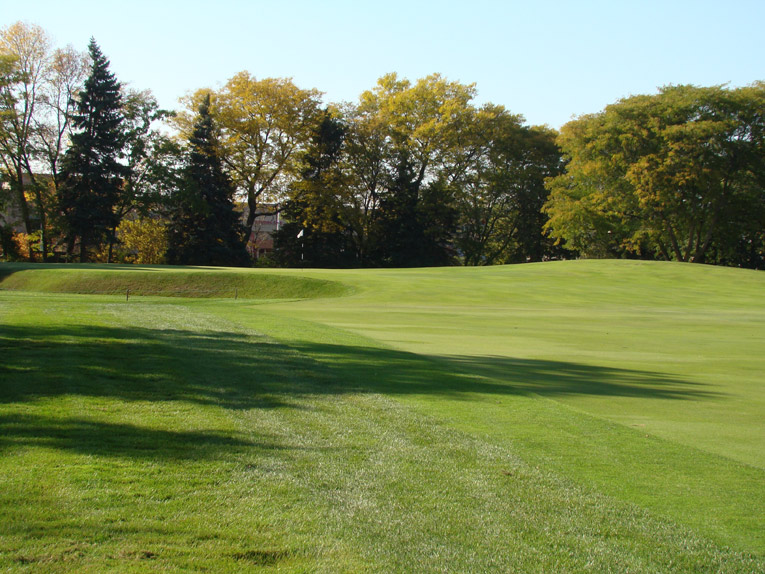
Regardless of age or ability, every golfer delights in the challenge of a Redan green such as the first at Blue Mound. The tiger might draw his approach to help his ball release to back hole locations. Meanwhile, golfers with more modest ambitions are free to run their approach up the open right front of the green.
Second hole, 415 yards; The brilliance of Raynor’s work on flat land is that he rarely disturbed much land from tee to green. This is apparent at Shoreacres, Fairfield, Charleston, Yeamans Hall, et al. Here at the second the tee pad is not built up to provide the player a comfortable view of the fairway. Rather, Raynor concentrated his dirt moving efforts in building an enormous green pad. His bunkers aren’t so much deep as his green pads are tall. Of all the green complexes in his repertoire, the Double Plateau affords the most varied hole locations and the one found here is a mighty fine version.
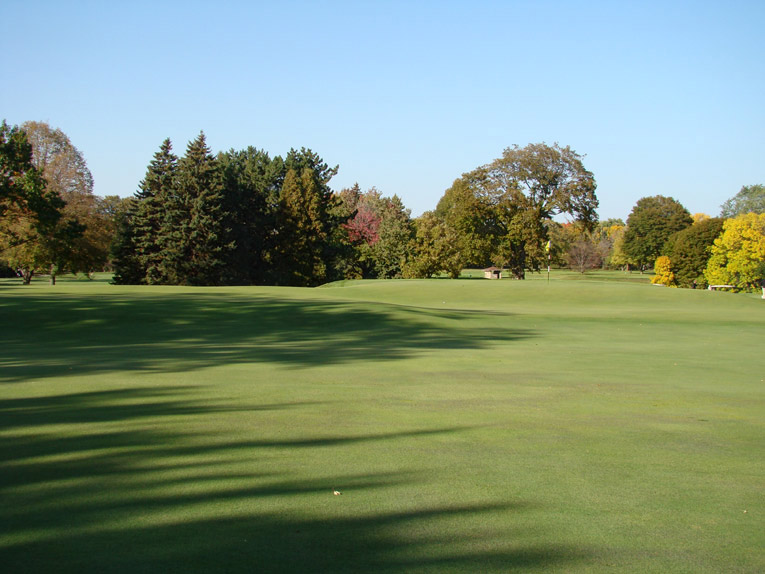
The killer hole location is on the back right plateau as seen above. The front left plateau is in the afternoon shadow. Just ten years ago, much of the lower front section was not even maintained as putting surface but now the nearly 9,000 square foot green is properly – and perfectly – presented. Beware the hidden deep bunkers back left and right!
Third hole, 220 yards; Given the unsurpassed drama created at the ninth at Yale, a Raynor-phile is surprised to realize how many Biarritz holes are actually laid over relatively flat land: Yeamans, Chicago, Shoreacres, Piping Rock to name a few. This one is as good or better than those four. In fact, Hepner opines: “Individually, perhaps none of Raynor’s four one shotters at Blue Mound are the very best of their class. However, cumulatively, I think they represent his finest set of one shot holes as each is of such a high standard.”
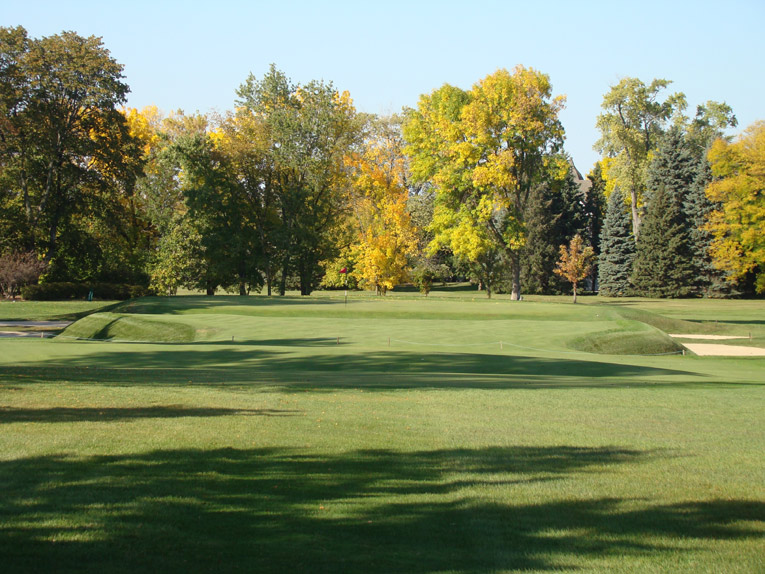
To Raynor’s credit, the view standing on the tee suggests he moved very little dirt. Yet, ….
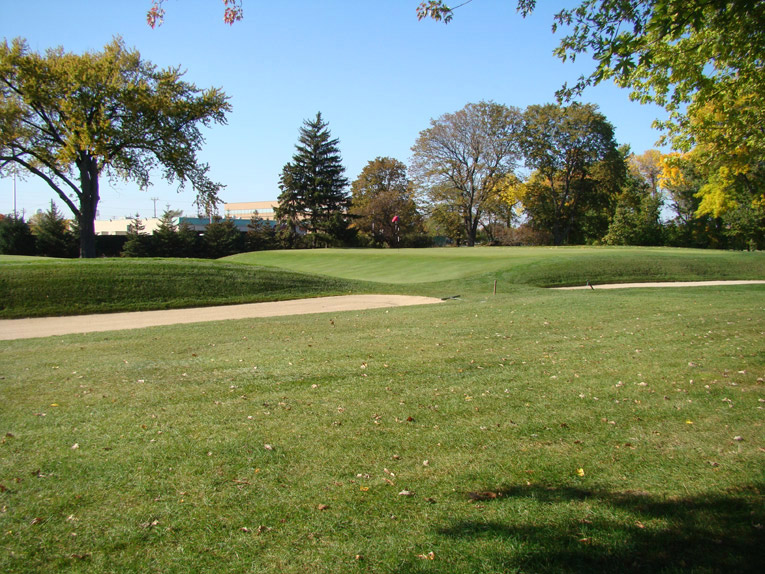
… this view from the right suggests otherwise. The ground in the foreground is at grade. Where Raynor got the huge amount of dirt to build up the two sections that are separated by the swale is a mystery!
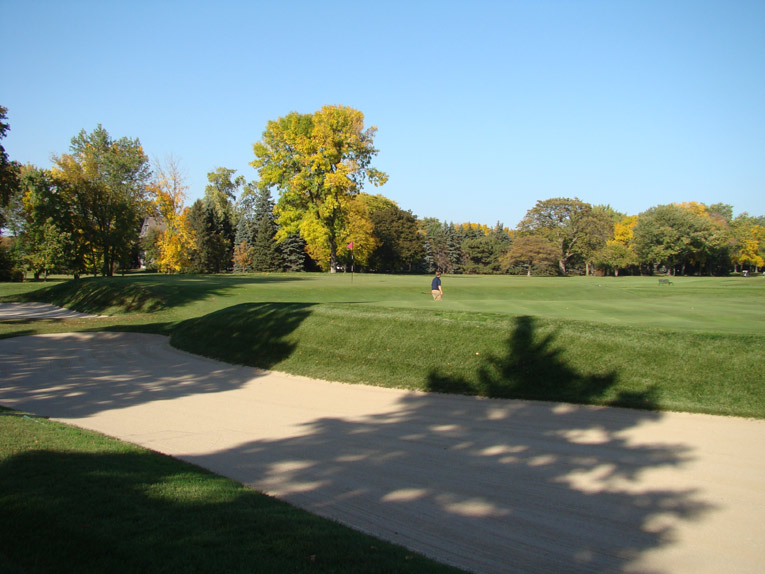
The detail work at Blue Mound is excellent. For example, the Biarritz bunkers short of the green extend well back as intended by Raynor. Note the depth of the swale measured against the waist of the golfer walking to play his ball from the right greenside bunker.
Fifth hole, 495 yards; When Charles Blair Macdonald (Raynor’s mentor) lived in Scotland the famous Road Hole at St. Andrews was unequivocally a par five. Measuring 460 yards, the hole was rarely reached in two with a feathery. Matters changed early in the last century after the introduction of the gutta percha ball. Suddenly, the seventeenth became attainable if the wind helped and fairways were firm. Blue Mound’s version went through a similar evolutionary change in technology. Orginially opened during the age of hickory shafts, the green was difficult to reach in two. Equipped today with 460cc drivers, many more golfers have a go at the green in two than in Raynor’s day. However, successfully avoiding the deep bunkers front and back and holding the plateau Road green remains vexing.
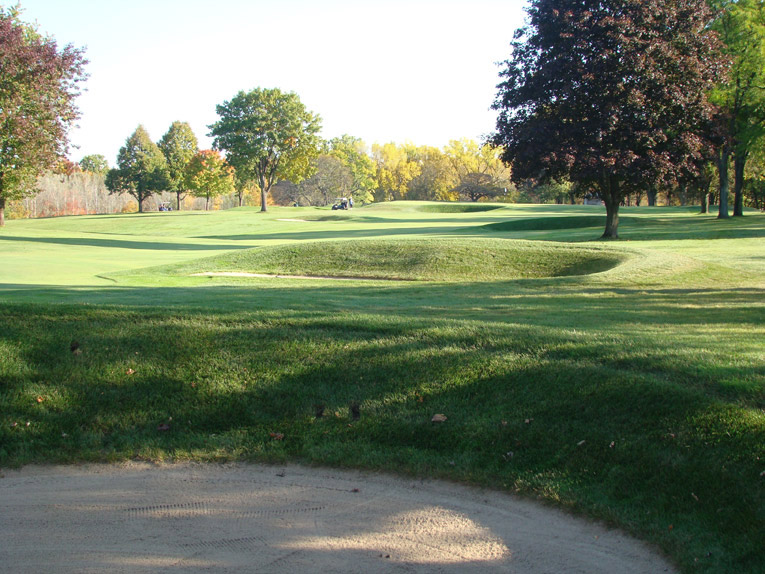
These fairway bunkers along the right are meant to force the golfer left ala the sheds and out of bounds on the Road Hole at St. Andrews.
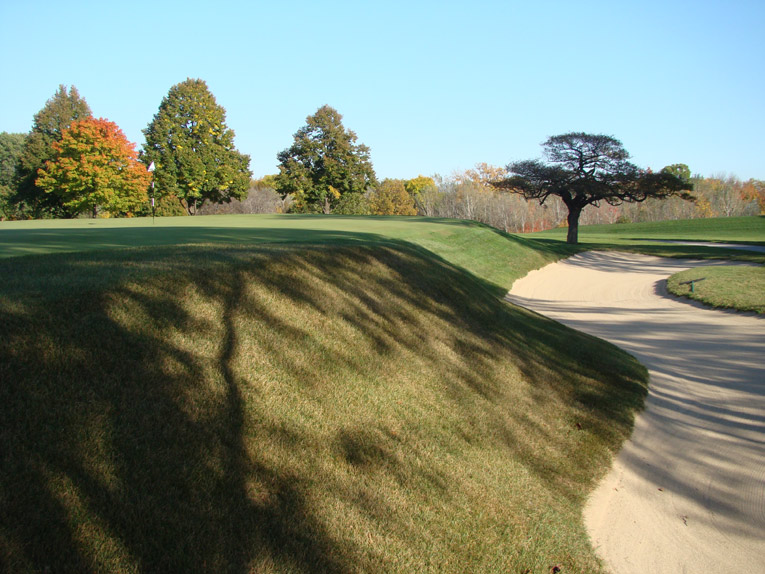
Recovery from the long bunker that hugs the back of the Road green is always problematic.
Sixth hole, 335 yards; A teaser that takes the golfer into the prettiest section of the property, most people favor restraint off the tee to leave a full short iron second in order to find the proper level on this two tier green. When asked prior to a Wisconsin State Amateur what the winning score would be, Barry Linhart responded, “ Depends on where I set the hole locations!’ By that, he meant that much of the challenge at Blue Mound is found at its green complexes. In the case of the sixth, back hole locations are particularly difficult because the back shelf is none too big and death is over. Linhart goes on to add ‘That’s why Blue Mound never gets boring to play. Each hole plays so differently everyday because of the variety and availability of so many interesting and difficult hole locations.’
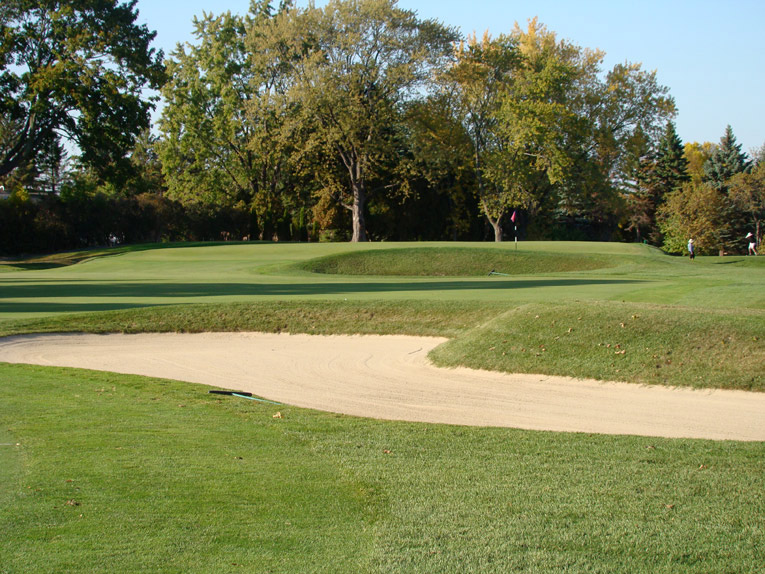
Great green complexes provide great hole locations and above is an example. Raynor gives the golfer room to operate and avoid flirting with the deep front right bunker by using a ridge behind the hole as a back board.
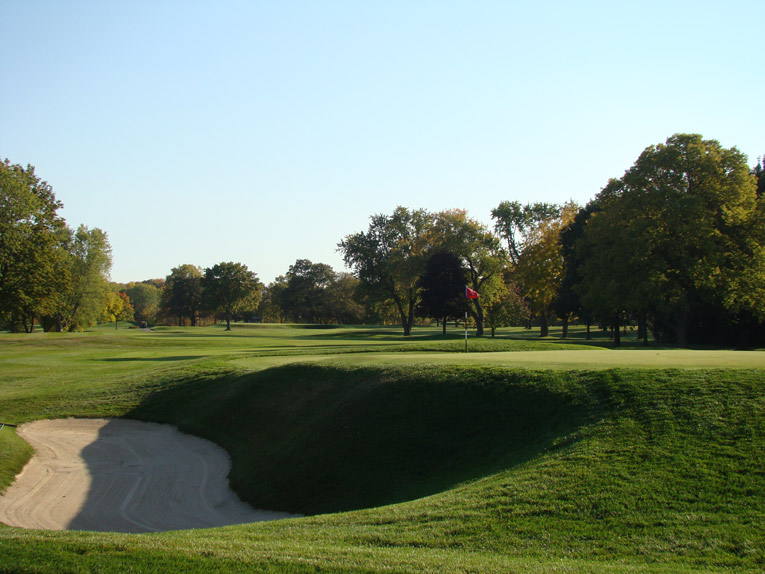
As seen from behind, the bunker to the right of the sixth green gets deeper as the green pad gets taller.
Seventh hole, 165 yards; Raynor never visited Scotland so he might not have known that the fourth at Brancaster which inspired Macdonald’s Short, plays slightly uphill. Raynor knew that the Short at National Golf Links of America plays downhill to a wide green and visible putting surface. Hence, Raynor had no compunction in placing his Short green complexes below – sometimes well below – the teeing ground. Thanks to all the recent fine work (i.e. tree removal, bunker work and green expansion to where the green now measures 38 yards in width and 28 yards deep), this Short Hole has a sense of scale and grandeur that few other Shorts can match.
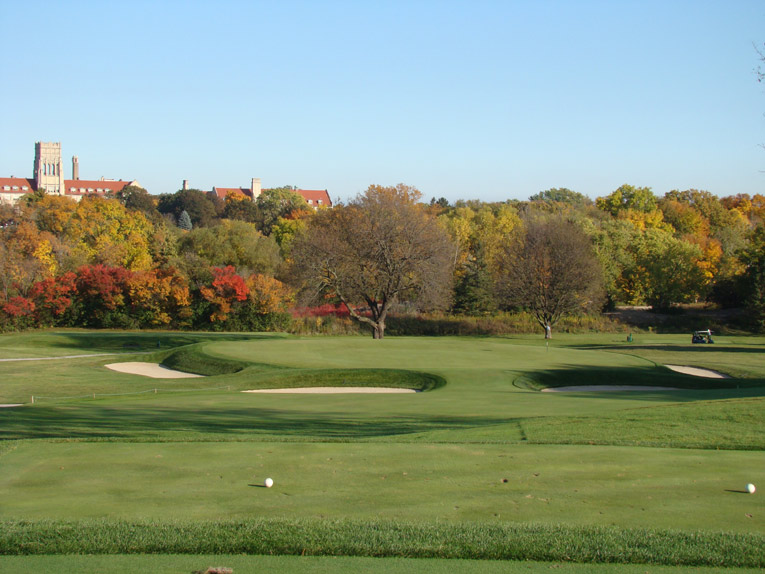
Raynor saw the drop in elevation into the Menomonee River Valley as the perfect opportunity to build a Short Hole. The sight of Mount Mary College (whose impressive tower was actually built three years after the course opened) is an added bonus. All told, this is one of Raynor’s most striking Short Holes.
Eighth hole, 445 yards; Uphill holes are often joyless but not here. In fact, the single most exhilarating shot at Blue Mound may be the approach with a long iron or utility club into this 7,900 square foot Punchbowl green that plays even bigger. Unusual for a Punchbowl, this one features really fine interior contours that serve to drain water off the green’s front left. Merely hitting the green is no guarantee of a par. Any eclectic list of Raynor’s best holes must include Blue Mound’s eighth.
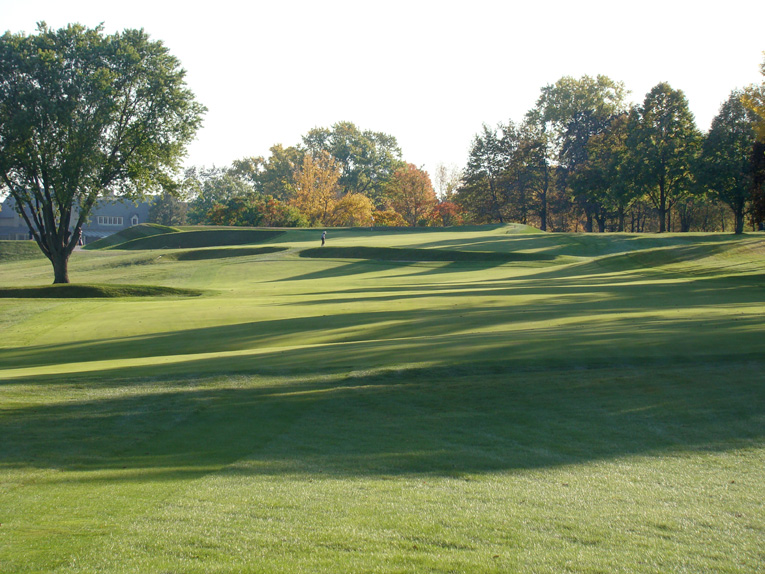
On a picture perfect fall day with the afternoon shadows stretching across the fairway, the golfer doesn’t view scaling the hill to the green as a chore. Raynor’s cross bunkers short help break up the line while adding visual interest. On top, the Punchbowl green acts as a gaint catcher’s mitt, screaming for a bold, well played shot.
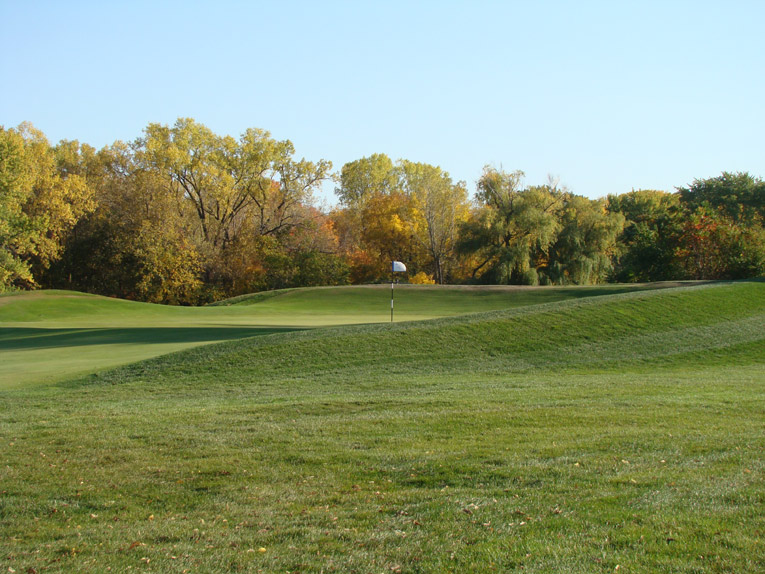
As seen from the right, note how high the short grass extends up the face of the Punchbowl walls. In this manner, all kinds of interesting things can happen. Such wasn’t the case ten years ago. At the time, it was a much smaller green surrounded by a blue grass bowl. The restoration process saw 3,000 square feet of tight short grass added into the playing mix, lending this hole its superlative playing characteristics.
Ninth hole, 375 yards; The newly restored bunkers on the right are the best set of fairway bunkers on the course and create a nice tension with the ravine along the left. This remains a particularly fine driving hole even though it plays shorter with today’s equipment than Raynor would deem preferable. Along with the fourth, this green possesses the most back to front tilt on the course so staying below the hole is important. In trying to do so, the green’s natural false front becomes the predominant feature of which the golfer must be wary.
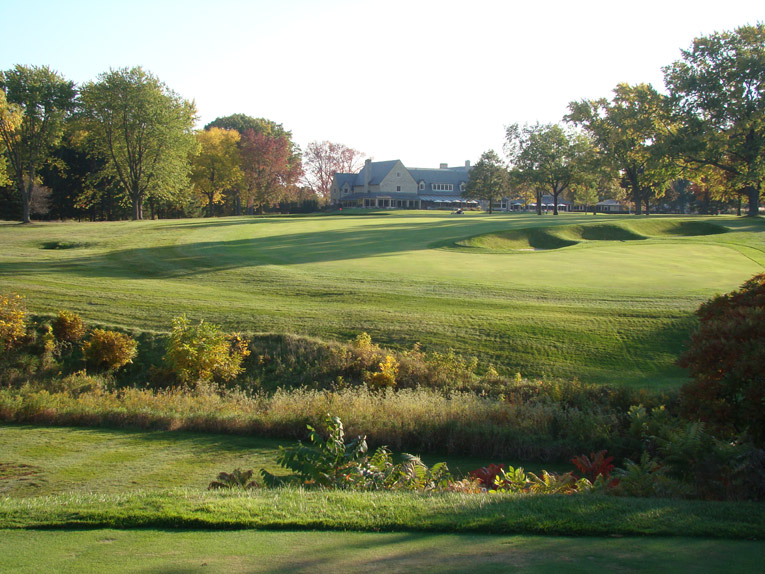
Hepner restored the three bunkers on the right and they give the club golfer much about which to think.
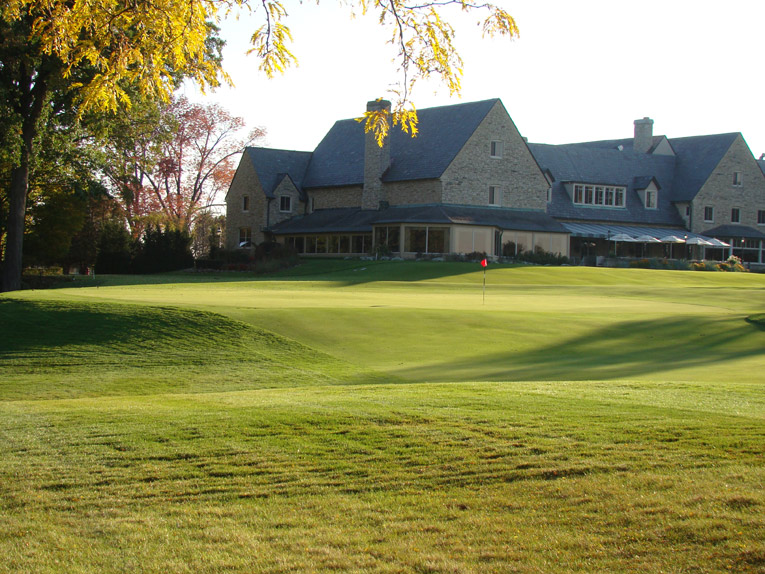
The stone clubhouse and its slate roof provide a handsome backdrop to the most graceful green complex on the course.
Eleventh hole, 380 yards; This is a great transition hole between the flatter property and that portion with more natural features. On the straightaway drive Raynor does nothing to preview the green’s precarious perch.
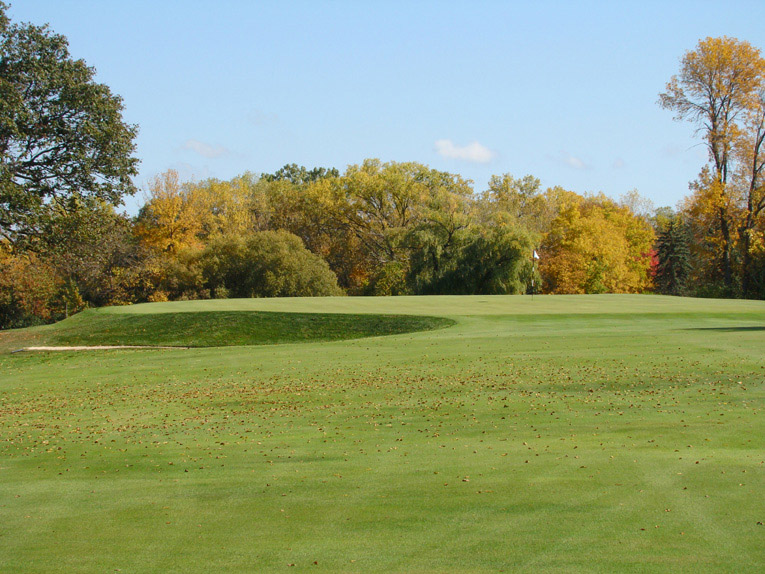
Given that this hole parallels the tenth which is played over relatively flat land, one might assume that this approach is straightforward with little peril. However, …
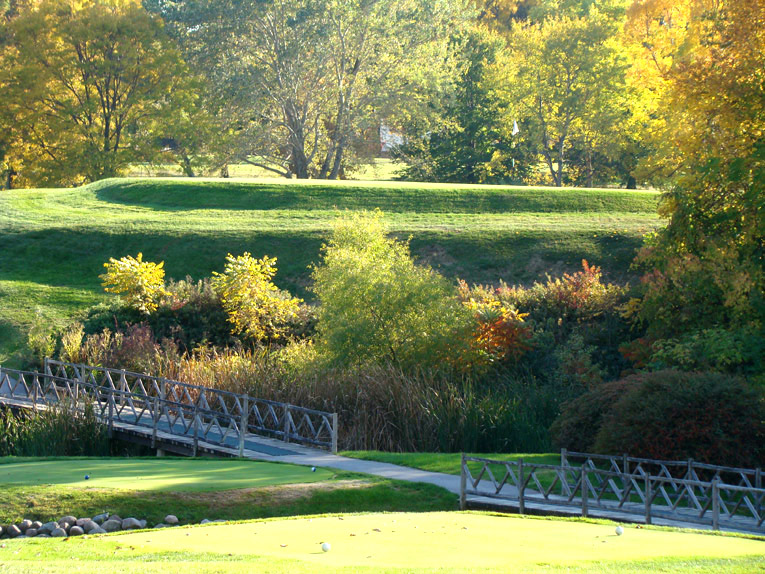
… such a conclusion would be wrong! A nine foot deep bunker wraps around the right and back and misses to the left are even worse as indicated by this view from behind the green.
Twelfth hole, 480 yards; Hog’s Back holes are confounding to play, especially when firm conditions are present. Blue Mound has long been hailed as one of the best maintained/presented courses in the Midwest and Green Keeper Tim Venes’s work shines even brighter on a subtle hole like this. Any kind of a draw left of center will hit the crowned fairway and likely be shrugged off into the rough. Similar fates await fades hit right of center. Given the hole’s length and interesting putting surface, approach shots played from the rough generally herald a slow march toward bogey.
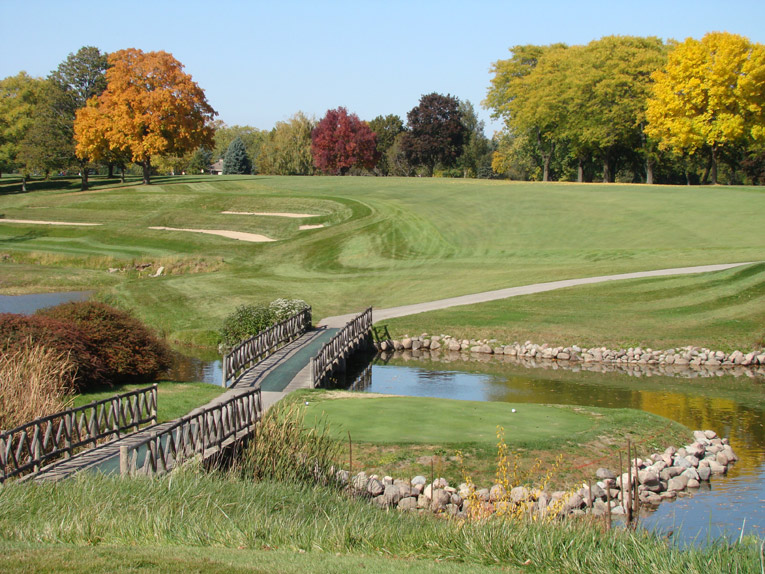
Lots of drama from the twelfth tee but the real danger for the good player is the crowned fairway that Raynor achieved by expertly draping it over a ridge line.
Thirteenth hole, 185 yards; Raynor’s ground game design features play properly at Blue Mound. Here is such an example where the high rough line to the right and the quintessential right to left slope enable this Redan to play as well as his more noted designs. The firm, true running surfaces mean that golf at Blue Mound is a delight no matter one’s age, be it fifteen, forty or sixty-five years old.
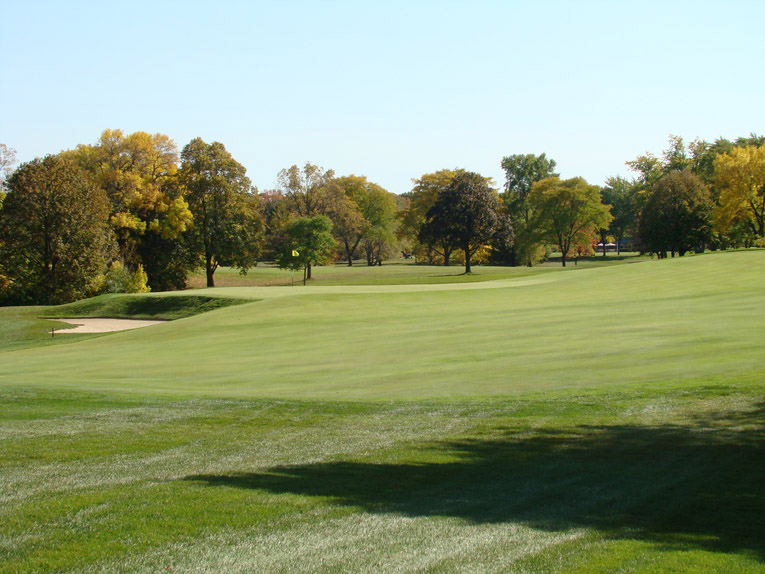
The classic high front right to lower back left slope is even more pronounced at the Redan par three than at the Redan two shot first hole
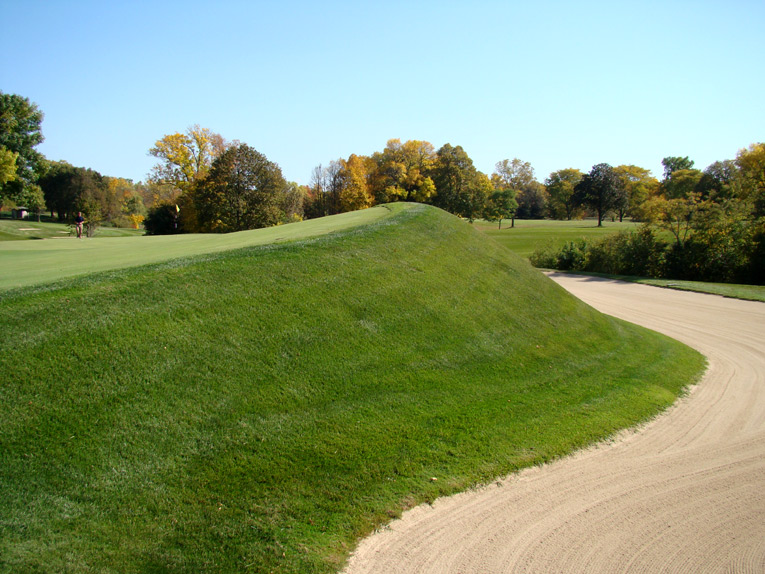
Though not always easy to achieve, the green keeping staff at Blue Mound do all they can to present short grass on the high side of holes. Options galore are the result for the thinking golfer.
Seventeenth hole, 190 yards; A hump in the back middle right of the green bestows this Eden with its own unique playing characteristics. Guarded by a seriously deep Hill bunker left that hides the head of a golfer playing a bunker shot from his greened opponent the 17th is a strong penultimate hole. A rear sand pit represents the Eden River at St. Andrews and combines with a longish Strath bunker to make right hole locations especially exacting. While the Biarritz and Eden were situated across flat land, Raynor imbued them with such superb quality that they compare favorably with the Short and Redan that enjoy superior natural features. One grimaces to think what modern architects might have done over similar flat land. Pete Dye (who acknowledges the heavy influence of Raynor on his own work) often resorted to unnatural earth moving to give his flat land par threes character. Witness the front nine at Crooked Stick where the third is goofy and water is a crutch at the sixth.
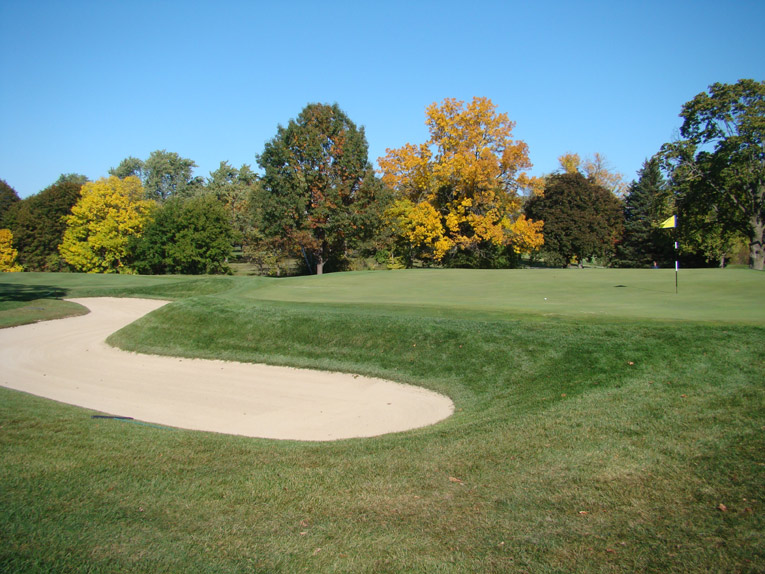
As seen from the back right hand side of the green, note the hump and its impact on today’s hole location. Golfers whose tee balls don’t find this relatively small section of the green will be reminded of St. Andrews which perfected the concept of large greens that are difficult to two putt.
Eighteenth hole, 560 yards; The Old Course at St. Andrews epitomized golf to Charles Blair Macdonald. In addition to the Road Hole, he frequently used design tenets from the Eden and Long. One benefit of switching the nines at Blue Mound is that the golfer concludes his round with both these much respected hole types, a fitting conclusion indeed.
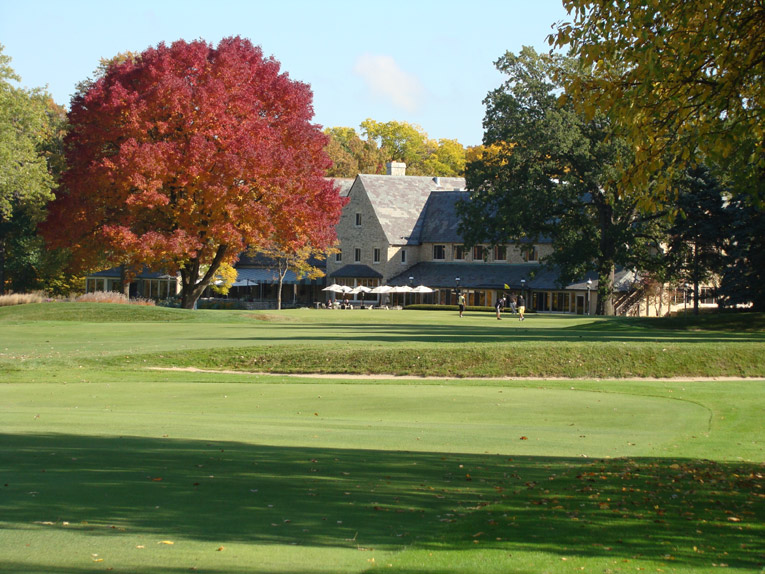
There are plenty of other noteworthy features on this course in addition to the holes listed. The fiercely tilted putting surface at the monstrous 9,900 square foot Alps fourth green is one. Another is the convoluted tenth green which rises up from the fairway. Ben Crenshaw’s jaw dropped as he stood admiring the triple plateau tenth green during a tour with Bruce Hepner a few years ago.
While a round at Blue Mound won’t be confused for the rollicking rollercoaster rides at the more dramatic Yale or Fishers Island, it is a strategic and aesthetic delight. Hepner refers to the course as being ‘dialed in’ meaning that everything from the mowing lines to the condition and firmness of the turf are pitch perfect. Every detail, no matter how fine, is optimally presented and that is simply not true at 99% of the courses in North America. Though this 6,700 yard course will no longer host a PGA Championship as it did in 1933 (won by Gene Sarazen), Blue Mound offers something far better: A course that its members relish playing each and every time out and one that they never tire of playing. Few clubs can claim the same.



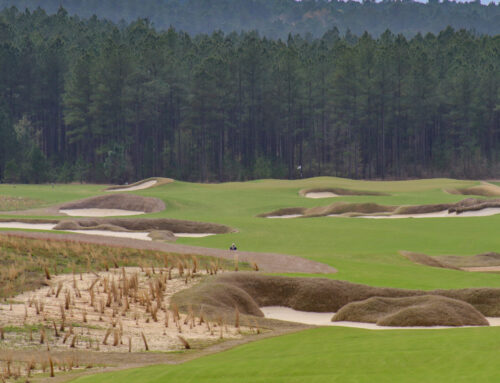


![The Park, West Palm (Lit 9) [2023]](https://golfclubatlas.com/wp-content/uploads/2024/12/IMG_7092-2-scaled-500x383.jpg)

